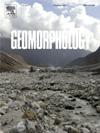火星祝融着陆区横向风化脊(TAR)的自动提取及地貌影响分析
IF 3.1
2区 地球科学
Q2 GEOGRAPHY, PHYSICAL
引用次数: 0
摘要
横向风化脊(TARs)的形态和表面特征反映了火星近期和当前的环境演变。本研究利用祝融号探测器在乌托邦平原南部着陆区的多源高分辨率轨道器图像,研究了典型火星非风化地貌对TARs分布和形态的影响。本研究提出了一种自动、有效的方法来提取TAR,同时对其类型进行分类,并估算其几何参数,包括长度、宽度、高度和角度。研究结果证实了所提方法的有效性。在祝融号探测器着陆区,平坦区域的TAR分布稀疏,形态简单。然而,在典型的非风化地貌(如圆锥和槽谷)周围,TARs 的分布更为集中,形态也更为多样。TARs的走向由风向决定,其宽度受沉积物丰富程度的影响。TARs的形态和分布还受到典型的非风成陆地貌的影响,这些地貌改变了当地的风场和沉积物。本文章由计算机程序翻译,如有差异,请以英文原文为准。
Automatic extraction of Transverse Aeolian Ridges (TARs) and analysis of landform influence for the Zhurong landing area on Mars
The morphology and surface characteristics of Transverse Aeolian Ridges (TARs) reflect the recent and current environmental evolution of Mars. This study investigates the influence of typical Martian non-aeolian landforms impacted on the distribution and morphology of TARs using multi-source high-resolution orbiter images in the Zhurong rover's landing region at the south of Utopian Plain. This study proposes an automatic and effective approach for extracting TARs, while classifying their types and estimating their geometric parameters, including length, width, height, and angle. The obtained results confirm the effectiveness of the proposed method. In the Zhurong rover's landing region, TARs in flat areas have a sparse distribution and simple morphology. However, TARs are more concentrated and diverse in morphology around typical non-aeolian landforms such as cones and troughs. The orientation of TARs is determined by wind direction, and their width is affected by sediment richness. The morphology and distribution of TARs are also influenced by typical non-aeolian landforms, which modify local wind fields and sediments.
求助全文
通过发布文献求助,成功后即可免费获取论文全文。
去求助
来源期刊

Geomorphology
地学-地球科学综合
CiteScore
8.00
自引率
10.30%
发文量
309
审稿时长
3.4 months
期刊介绍:
Our journal''s scope includes geomorphic themes of: tectonics and regional structure; glacial processes and landforms; fluvial sequences, Quaternary environmental change and dating; fluvial processes and landforms; mass movement, slopes and periglacial processes; hillslopes and soil erosion; weathering, karst and soils; aeolian processes and landforms, coastal dunes and arid environments; coastal and marine processes, estuaries and lakes; modelling, theoretical and quantitative geomorphology; DEM, GIS and remote sensing methods and applications; hazards, applied and planetary geomorphology; and volcanics.
 求助内容:
求助内容: 应助结果提醒方式:
应助结果提醒方式:


